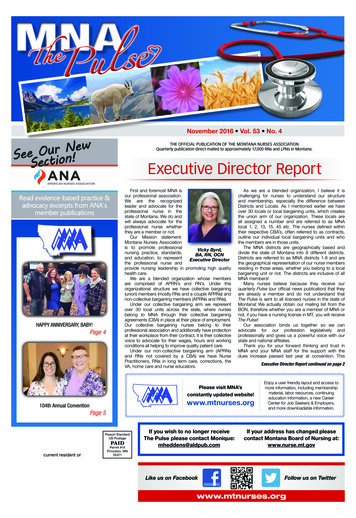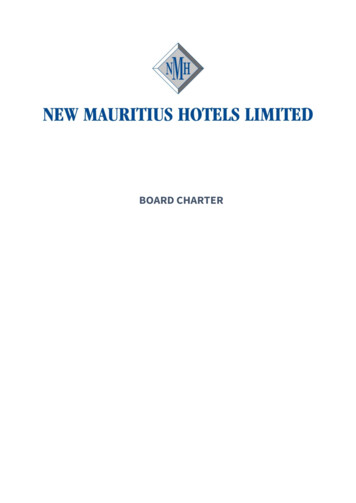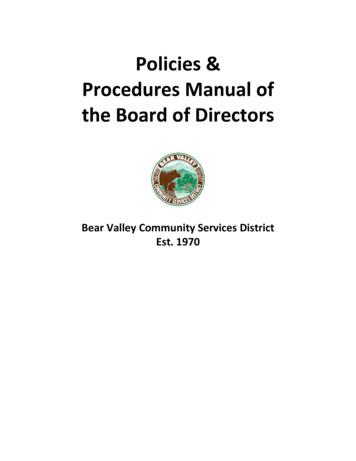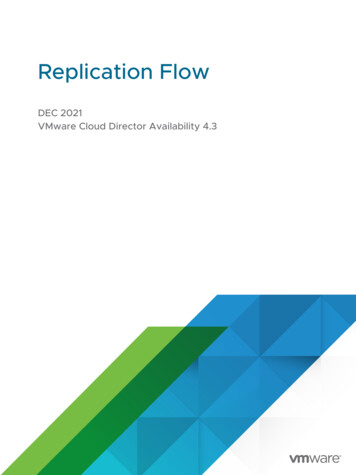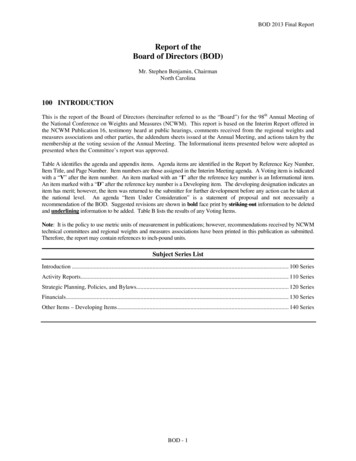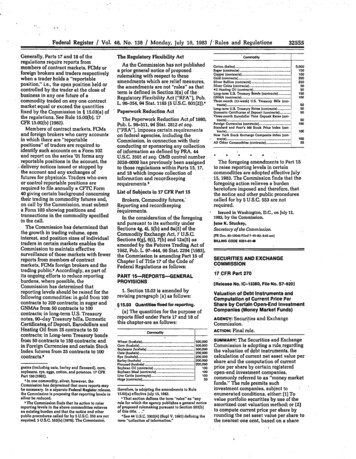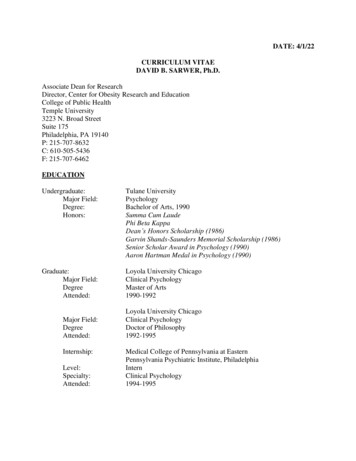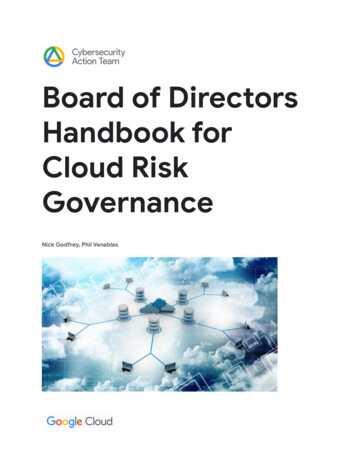
Transcription
Board of DirectorsHandbook forCloud RiskGovernanceNick Godfrey, Phil Venables
Table of ContentsIntroduction3Executive Summary4The What and Why of Cloud5Cloud as a Means of Managing Risk6Cybersecurity6Resilience7Technology risk8Cloud Security and Control Characteristics9Shared fate, not shared responsibility9How control design evolves10How control ownership evolves11Managing control transitions12Establishing Cloud Risk Governance12Adopting a phased approach13Governance structures14Skills, organization and culture14Adjusting and right-sizing controls15The compliance program for cloud15The audit program for cloud16Communicating with the board16Board Oversight17As always, focus on risk17Conduct incident reviews and drills18Test through scenarios18Top 10 Questions to Ask in the Boardroom19Conclusion25For more information visit gcat.google.com
IntroductionThis paper is for the Boards of Directors of organizations that are engaging in a new, or substantiallyincreased, adoption of cloud technology perhaps as part of a wider digital transformation of theirbusiness.We aim to offer practical guidance, in the form of questions that can help structure your oversight of,and engagement with, management’s approach to adopting cloud, and to ensure that independent riskand audit functions are appropriately equipped to support that process.To suggest, however, that your organization’s adoption of cloud is simply a new series of risks to managewould be wrong. The adoption of cloud is in many cases an increasing imperative for organizationsto remain competitive and to fully realize technology, data and overarching business strategies. And,beyond that, the adoption of cloud is a significant opportunity for organizations to reimagine how wholeclasses of enterprise risk1 can be better managed, and presents opportunities to tackle risks thatpreviously would have been commercially unrealistic to fully address.This paper will therefore provide an overview of the key tenets of cloud technology, why it is increasinglyimportant in realizing business strategies, the risk benefits of a well-executed cloud adoption, and ourguidance for Boards of Directors in their oversight of that adoption.1Including operational risk, technology risk, compliance risk and strategic riskFor more information visit gcat.google.com
Executive SummaryThe adoption of cloud, at scale, by a large enterprise requires the orchestration of a number ofsignificant activities, including: Rethinking how technology is leveraged to achieve strategic outcomes, and changing how softwareis designed, delivered, managed across the organization to enable those outcomes.Refactoring security, controls and risk governance processes to ensure that the organization stayswithin risk appetite and in compliance with regulation during and following the transformation.Implementing new organizational and operating models, enabling a broad and deep skills andcapabilities uplift, and fostering the right culture for success.As such, the organization across all lines of defense, has significant work to do. The board of directorsplays a key role in overseeing and supporting management on this journey, and this paper is designedto provide a guide to boards in that position. In particular, we provide the top 10 questions to be askedin the boardroom, listed below and expanded on in the body of the paper with supplementary pointsand possible red flags to watch for:1.How is the use of cloud technology being governed within the organization? Is clear accountabilityassigned and is there clarity of responsibility in decision making structures?2.How well does the use of cloud technology align with, and support, the technology and datastrategy for the organization, and, ideally, the overarching business strategy, in order that the cloudapproach can be tailored to achieve those right outcomes?3.Is there a clear technical and architectural approach for the use of cloud, that incorporates thecontrols necessary to ensure that infrastructure and applications are deployed and maintained ina secure state?4. Has a skills and capabilities assessment been conducted, in order to determine what investmentsare needed across the organization?5. How is the organization structure and operating model evolving to both fully leverage cloud, butalso to increase the likelihood of a secure and compliant adoption?6.How are risk and control frameworks being adjusted, with an emphasis on understanding how theorganization’s risk profile is changing and how the organization is staying within risk appetite?7.How are independent risk and audit functions adjusting their approach in light of the organization’sadoption of cloud?8.How are regulators and other authorities being engaged, in order to keep them informed andabreast of the organization’s strategy and of the plans for the migration of specific businessprocesses and data sets?9.How is the organization prioritizing resourcing to enable the adoption of cloud, but also to maintainadequate focus on managing existing and legacy technologies?10. Is the organization consuming and adopting the cloud provider’s set of best practices andleveraging the lessons the cloud provider will have learned from their other customers?For more information visit gcat.google.com
The What and Why of CloudIt may be tempting to think of cloud as simply ‘someone else’s computers’ that your organization uses,instead of building and maintaining its own, and in the most primitive sense, the infrastructure that cloudproviders build and operate are similar to those hosted in your organization’s data centers. However,taking this view would overlook some of the fundamental differences between cloud and on-premisetechnology, and as such it risks obscuring the opportunities that cloud presents to an organization.Instead, think of cloud as a different way to leverage technology to drive your business strategy: onewhere your organization uses new technologies and methods of delivering technology, to redesign andredefine relationships with their customers, employees, and partners. At Google Cloud we use thefollowing definition to describe such a digital transformation:Digital transformation uses modern digital technologies—including all types of public, private, and hybridcloud platforms—to create or modify business processes, culture, and customer experiencesto meet changing business and market dynamics.Viewed from this perspective, there is an increasing imperative for adopting a cloud-enabled digitaltransformation in terms of the agility, quality of product and services provided to customers, andrelevance in the marketplace (particularly in industries that are prone to disruption by new technologyenabled entrants). As such not adopting cloud could result in strategic disadvantage.Further, because cloud service providers manage data centers, networks, compute and storage as theircore business, they have the capacity and capabilities to manage that infrastructure at huge scale andto extremely high standards, incorporating security capabilities that are uneconomic for companies thatbuild their own infrastructure and data centers. As such, as we will see in the next section, far from beingjust a new risk to manage, cloud is an opportunity to improve a range of operational risk profiles in yourorganization and to focus your organization’s technology resources (developers and engineers) more onimproving business and customer experiences, and less on managing underlying infrastructure.For more information visit gcat.google.com
Cloud as a Means of Managing RiskAdopting cloud technologies, and adjusting businesspractices, processes and operating models tofully gain from the advantages of cloud, providesorganizations with an opportunity to step changetheir management of operational risk. For example,the following risks can be addressed and mitigatedusing cloud in ways that are either technically,organizationally or economically not viable withtraditional on-premise technologies.CybersecurityCloud providers typically have a global scaleinfrastructure designed to provide security throughthe entire information processing lifecycle. And thesheer scale of cloud service providers (in terms ofpersonnel, volumes of servers, extent and reachof global networks) means they are able to investin approaches to security that are beyond2 thetechnical and commercial means of most otherorganizations, simply because the scale drives downthe unit cost of that security.These capabilities include: pervasive, and sometimesby-default (at Google Cloud, we encrypt data at restby default, with no action needed by the customer3),encryption of data; internet-scale capacity to deflectdenial of service attacks; feature-rich data lossprevention technologies; the capacity to storeunparalleled volumes of security logs and threatintelligence; and sophisticated tooling to manageidentity and access to resources. In addition, ofcourse, the cloud provider takes responsibility forthe security of data centers, physical servers andnetwork infrastructure, and for the patching of encryption/default-encryptionFor more information visit gcat.google.com
ResilienceCloud providers operate data centers, with advanced physical security, in locations around the world.This, coupled with the scale of these data centers (the volumes of servers they hold for example), andthe abstraction of physical technology from customer applications, means that customers of cloudproviders benefit from layers of ‘built in’ resilience: In effect, the customer is shielded from the effectsof component failures (e.g. server hardware failure), data center infrastructure events (such as powerfailures), all the way up to country-wide events (such as severe weather). Of course, organizations needto architecture their applications to take advantage of these inherent resilience properties.4In addition to this technical resilience, a broader operational resilience can be achieved using a multicloud approach. Specifically, by leveraging two or more cloud providers (or an on-premise capabilityto supplement a single cloud provider - how we define hybrid cloud), organizations can leverage opensource based technologies and management and control planes to build exit strategies to mitigatevarious scenarios and to meet the requirements of regulators in some s-multicloud-as-riskmitigation-strategy5For more information visit gcat.google.com
Technology riskMany organizations are at an inflection point regarding their technology. In the 50 or so years sincelarge organizations started using Mainframes, trillions of dollars has been invested in largely on-premise,self-managed technology. Historically, this meant organizations building their own data centers, globalnetworks, managing hundreds of thousands of servers and PCs, and writing proprietary applications.Enterprises, and their customers now expect to be able to access digitized products and services at anytime, through a range of channels. And, as we as a sector have seen, the complexities of achieving thison top of existing technologies can result in significant technical and operational failures.So there are compelling arguments for a strategic overhaul of the technology used by manyorganizations. However the costs, and timescales, involved with refactoring existing technologies usingthe traditional methods of delivering IT (on premise and/or using traditional outsourcing models) aresuch that it is unlikely to be an achievable strategy for most organizations. In part this is because thetraditional models involve the organization managing, as we have discussed, everything from the datacenter upwards.By migrating to cloud, organizations can ensure that their technology teams are focussed on deliveringhigh-quality services and experiences to customers, and not on operating foundational technologies,and materially reduce their Technology Risk profile as a consequence. For example: Operate above the infrastructure. By migrating to cloud, they no longer have to dedicate resourcesto managing data centers, physical servers and network equipment, nor do they have to worryabout patching or maintaining core operating systems.Use cloud to reduce technical debt. Even if a given application is not going to be fully modernized perhaps it will be demised in the foreseeable future - organizations can reduce the technical debtassociated (e.g. unsupported hardware or operating system) with it by migrating it into a containerimage that runs in the cloud.For more information visit gcat.google.com
Cloud Security and Control CharacteristicsThe mechanisms used to secure and control cloud technologies can be substantially different to thoseused for on-premise technologies. Given that, it is important that your organization’s control functionsre-evaluate relevant key controls: even if the objectives behind existing controls are still valid, the specificsof the control, and the approach to managing it, will often need to evolve in order that the original controlobjective is still met in a cloud environment. In fact, using cloud native controls instead of relying onexisting controls will often produce better outcomes because they are designed with cloud in mind.Shared fate, not shared responsibilityOne of the most substantial differences between cloud service provider technologies and on premisetechnology is that there is a new party involved in the successful operation of key controls (the cloudservice provider). Historically, and typically, this arrangement is defined as a ‘shared responsibility’ andoften depicted as shown here:Figure 1. Your responsibilities and your cloud service provider’sresponsibilities under the cloud shared-responsibility model.For more information visit gcat.google.com
However, getting security right in the cloud can be challenging, and the shared responsibility modelimplies that customers are responsible for building effective cloud security programs on their own.Specifically, the shared responsibility model for security that has underpinned cloud computing sinceits earliest days dictates that the cloud provider is responsible for securing the underlying foundation,while the customer is responsible for secure configuration, data protection, access permissions andmuch more. The result is that enterprises have viewed the cloud as a risk to be managed instead of aplatform for managing risk.Instead, we believe the term ‘shared fate’ better describes the relationship between Google Cloud andour customers and how in practice the job of securing the cloud requires a partnership. As part of thisapproach, your technology and security teams will have access to tooling and solutions, provided byGoogle Cloud, that are designed to simplify the processes of building and maintaining a secure cloudenvironment. This includes solutions that encapsulate our opinion on how best to implement GoogleCloud securely, including landing zones, blueprints and secure by default products.How control design evolvesIn addition to not having direct responsibility for all technology controls, as described above, the natureof the controls your organization does still have responsibility for, evolves. That’s because the use ofcloud technologies will likely introduce a level of agility, speed and automation that is rarely the casewith traditional technologies. Cloud also offers the opportunity to increase the quality, completenessand transparency of controls, and your organization’s control owners will be considering the following: Cloud native vs existing controls. The nature of cloud technology is such that control approachesthat are generally unachievable with on premise technologies, like encryption by default, are nowavailable. Using these cloud native approaches will generally yield better results because they aredesigned with cloud in mind. Embedding policy and controls into code and automation. Cloud technologies can be deployedand managed using code interacting with APIs provided by the cloud provider. And when youmanage the cloud in this way, you can integrate your policies and controls directly in the code,making them central to both your company’s development process and to any software that yourcompany develops. Data-driven control assurance. Leveraging the fact that all cloud technology is declared anddiscoverable in data, to build data-driven assurance processes that validate that the deployedinfrastructure and software is continuously meeting control requirements.For more information visit gcat.google.com
How control ownership evolvesControl owners, often referred to as the first line of defense, such as information security managers,technology managers, and the businesses, will undergo substantial changes in terms of how they fulfilltheir responsibilities in the cloud world. As we described in our complementary paper, Risk Governanceof Digital Transformation in the Cloud 6, the following are patterns you may see: Operating and organizational models. Many conventional controls associated with the safeoperation of IT and changes to business processes leverage central teams of specialists, who willvalidate or test the work of other teams prior to implementation. This is often the case, for example,with security teams that conduct penetration tests of systems prior to their release. In a cloudworld, such models may introduce unwanted delay because of the process handoffs and thus themost effective operating model for certain controls may in fact be where the execution of thosecontrols is federated through the wider organization. Increase in control telemetry for better oversight. As control owners move from a model of centralownership of control processes (“confidence through organizational hierarchy”), to one where thecontrol is operated in a far more federated manner, their approach to overseeing the control hasto change too. In this model, the control owner focuses on establishing the correct design andimplementation of the control, and then on the ongoing assurance of the control’s efficacy throughobserving it in data (“confidence through control on.pdfFor more information visit gcat.google.com
Managing control transitionsIn the majority of cases the adoption of cloud represents the introduction of a new technologyalongside the existing (probably on-premise) environment. And whilst, as we have described above,there is every reason to embrace the new cloud environments with new approaches to control, it isobviously critically important to maintain the existing controls on the on-premise technologies andassociated business processes.Establishing Cloud Risk GovernanceIn the preceding section we described some of the common characteristics of cloud security andcontrols, and how that might cause an adjustment of an organization’s control framework. In additionto this specific set of (mostly technical) decisions and activities, it is critical that the organizationestablishes a comprehensive approach to governing the adoption of cloud: in the same way thatcontrols need to evolve for the effective management of cloud, so does the organization’s broaderrisk and governance apparatus.The good news is that there is a logical startingpoint from which to build effective governancefor cloud: your organization likely already hassophisticated mechanisms for governing IT,data, systems and other related risks, and in theend (when the majority of IT and data is in thecloud), your cloud governance is in fact your IT,data and systems governance.Your organization’s Independent RiskManagement (IRM) function, in partnershipwith the first line of defense (control owners,IT management, lines of business), and thecompliance and audit functions, should ensurethat the transformation of those governancestructures is consistent with the guidance inthis section. The topics covered in this hereare described in significantly more detail in ourcomplementary paper, Risk Governance ofDigital Transformation in the Cloud overnance-of-digital-transformation.pdfFor more information visit gcat.google.com
Adopting a phased approachA cloud migration that is undertaken without sufficient planning to ensure the technology, securityand other teams involved are well-prepared and supported can bring both security and execution risk.However, attempting to define the end state of the various security, control, risk management andgovernance apparati, too early in the program, will likely be unsuccessful. Instead the IRM function,in partnership with the wider organization, should think of a phased approach by maturing constantlyas the work progresses.In other words, your organization can’t reasonably hold back all work until perfect readiness is in place,but similarly you can’t reasonably endorse proceeding with no initial planning and governance being inplace. We suggest there are four phases, although of course your organization may adopt a differentapproach to phasing or incrementing its program. Set the cornerstones: establishing a common understanding and the key principles that will shapethe intent and approach of the organization’s transformation over time. Manage the initial phases: implementing structures and apparatus that allow the organization tosafely conduct initial migrations to the cloud. These may include higher levels of manual checksand formal governance to mitigate the fact that controls may not all be fully matured at this stage. Mature and accelerate: adjusting control and governance structures to enable accelerated adoptionof cloud, by increasing control rigor and oversight, and right-sizing governance in parallel. The new steady state: adapting to broad usage by embedding cloud into all relevant risk programsand governance, and by implementing processes to maintain currency with cloud best practice.For more information visit gcat.google.com
Governance structures Program governance. An overall transformation program oversight group/committee and aprogram office with the relevant executive (business, technology and controls) leadershipoversight. Risk governance. A forum to ensure that risk management and governance is acting as a checkand balance to the program governance and there is sufficient time allocated to fulfill this oversight. Project governance. A mechanism to define the approved patterns available to applications teamsseeking to deploy into the cloud, and measures to track adherence to these and other requirements.It’s important that this is a streamlined process where the only roadblocks are those where teams,for whatever reason, have chosen to step away from the standard approach and tooling.Skills, organization and cultureAt its heart, despite being facilitated by the adoption of different technologies, a digital transformationis fundamentally about people, organizational structures, processes, procedures and “the way in whichthings are done”. Therefore, addressing these aspects as a high priority and as an integral part of thegovernance process is critical to success. Your organization should be focussed on the following, atleast: Training and skills development. A comprehensive and sustained training plan tailored for allstaff to develop deeper expertise in cloud technologies, but specifically for security and othersignificant aspects of risk mitigation. There should be provisions made to ensure that a significantportion of the training is on the specific policy and architecture choices the organization has made.This may initially be limited to certain core teams, but over time should be deployed pervasivelyto all relevant teams, and integrated into core training curricula. Organizational models. In addition to changes to formal organizational models, as describedpreceding sections, your company may wish to adopt more flexible operating constructs,where virtual teams work across boundaries with a focus on the product mission and less onorganizational hierarchy and traditional decision making processes. Strategically this is likely tobe important, and to help accelerate the overall program. To succeed, management needs toensure that these teams are empowered and equipped to make decisions quickly and to commitresources, but with the right guardrails to drive discipline in the process. Culture. Enabling this broad and deep transformation, including the re-skilling of large parts ofthe organization, and encouraging an innovative approach, needs to be a key focus area formanagement, from the top down. Specifically, reflecting the degree of change, and the uneasethat might create, you should look to ensure management are implementing approaches andleading with behaviors that fosters a culture that is supportive of these new ways of working, andprovides physiological safety to give their people confidence to adapt, try new things, positivelychallenge each other and management, and learn from the inevitable mistakes (which, with theright structures - such as the guardrails we have described - will be of limited consequence to theorganization as a whole and so tolerable at that level.)For more information visit gcat.google.com
Adjusting and right-sizing controlsAs discussed in earlier sections of this paper, the nature, operation and ownership of controls needs toevolve as part of a cloud transformation. The following, in particular, should be focus areas for theorganization. Cloud technology and security architecture governance.There should be explicit policies, standards andframeworks for how cloud deployments are undertakenand how they are adhered to. Initially, this may address asubset of the requirements and on the decisions neededto enable initial usage of the cloud in a controlled manner,using the governance described above. Over time, thesepolicies and frameworks can be extended and matured asthe organization gains experience if using cloud Software development lifecycle maturity. It is hard totake advantage and sustain the security risk mitigationcapabilities of the cloud without also progressivelymodernizing the software development lifecycle. Youshould expect management to explicitly determine howtechnology and business units are preparing for thatand question if expertise from cloud providers or otherexternal organizations is not being actively used.The compliance program for cloudThe compliance organization, which in most industries is responsible for ensuring the organization’scompliance with internal and external policies, standards, regulations and laws, has a significant role toplay in partnership with the risk function and the first line of defense. The exact delineation between anorganization’s risk and compliance functions will vary from company to company, but, regardless, theoverall set of activities remains consistent and the Board should look to the compliance function to fulfillthe following:Assessing regulations, standards, and laws that relate to the organization’s use of thecloud, including regulations that are specific to the cloud8. Ensuring ongoing compliance with the requirements stemming from regulation by baking them intothe policies, standards, frameworks and governance apparatus. Engaging with relevant regulators and supervisors, and overseeing the methodology and processesused to notify (or seek approval from) regulators at key junctures. Adjusting aspects of the compliance program as the use of cloud matures, including the regulationmonitoring and horizon-scanning ceFor more information visit gcat.google.com
The audit program for cloudThe Internal Audit function plays a critical and independent role to assess and provide assurance thatan organization’s approach to managing risks and controls, and its governance of those, is effective.As with all other functions described in this paper, Internal Audit is therefore a key component ofan organization’s safe and secure cloud digital transformation, at all phases. And, as with the otherfunctions, it is likely that some amount of adjustment to the audit program will be warranted. TheBoard should ensure that the following have been taken into consideration as part of that: Assessing and adjusting the audit universe. Does the set of auditable components sufficientlyreflect the risks associated with the organization’s cloud transformation? Does the audit coveragecycle need to be adjusted to ensure that audits of the cloud transformation are timely andreflective of the broader strategic journey and key milestones? Approaches to cloud audits. As we have discussed in this paper, the nature of public cloudtechnologies is such that management, and the risk function, will adopt approaches to controland risk management that differ to those used to manage much of a traditional technologyenvironment. For similar reasons, the audit function should consider how to adjust certain aspectsof the audit process in order to ensure relevancy and completeness, and to take advantage of thedifferent approaches to audit that cloud affords. Auditing the cloud service provider. Reflecting that, in all cloud delivery models, the cloud providermaintains significant responsibilities for risks that your organization is ultimately accountable for,such as physical security of the cloud service provider data centers, you should ensure that acomprehensive approach to auditing the provider is implemented.Communicating with the boardIn a wider transformation, or even in a tactical use of cloud services for specific projects it is importantto keep the Bo
Establishing Cloud Risk Governance 12 Adopt ing a phas e d approach 13 Governance structure s 14 Skills, organizat ion and cul ture 14 Adjust ing and right-siz ing controls 15 The compliance program for cloud 15 The audit program for cloud 16 Communicat ing wit h t he board 16 Board Oversight 17 As always, focus on risk 17
